Spatiotemporal Analysis of Road Crashes with Animals in Poland
Abstract
1. Introduction
1.1. The Problem of Road Animal–Vehicle Crashes
1.2. Literature Review
1.3. Article Content
2. Methods
2.1. Road Crash Data
2.2. Data on Wildlife Population Sizes and Hunting Districts
- Big game:
- ○
- Moose (Alces alces);
- ○
- Red deer (Cervus elaphus);
- ○
- Sika deer (Cervus nippon);
- ○
- European fallow deer (Dama dama);
- ○
- Roe deer (Capreolus);
- ○
- European mouflon (Ovis aries musimon);
- ○
- Wild boar (Sus scrofa).
- Small game:
- ○
- Red fox (Vulpes vulpes);
- ○
- Racoon dog (Nyctereutes);
- ○
- European badger (Meles meles);
- ○
- Golden jackal (Canis aureus);
- ○
- Marten (Martes);
- ○
- European mink (Mustela lutreola);
- ○
- European polecat (Mustela putorius);
- ○
- Raccoon (Procyon lotor);
- ○
- Muskrat (Ondatra zibethicus);
- ○
- European hare (Lepus europaeus);
- ○
- European rabbit (Oryctolagus cuniculus).
2.3. Road Network Data
2.4. Geospatial Analysis
2.5. Determination of Indicators
- The number of crashes, by year, month, and day of the week, broken down by the crash impacts;
- The number of crashes at particular hours by month;
- An analysis of the impact of the district type, category, and location on the number of crashes;
- An analysis of the impact of the number of crashes with the number of individual animal species;
- An analysis of the impact of the number of crashes with the number of animals per unit area;
- An analysis of the impact of the number of crashes per unit area with the number of animals;
- An analysis of the impact of the number of crashes with the number of animals per unit length of roads (in the variants for the secondary and tertiary categories);
- An analysis of the impact of the number of crashes per unit length of roads (in the variants for the secondary and tertiary categories) with the number of animals;
- An analysis of the impact of the changes in the numbers of animals in a district on the number of road crashes.
3. Results
3.1. Temporal Analysis of Animal–Vehicle Crashes
3.2. Impact of Parameters of the Hunting District, Its Category, and Location
3.3. Relationship between the Number of Crashes and the Wildlife Population Sizes
- The number of big game and the number of AVCs, the number of AVCs with injuries, and the number of fatal AVCs (Figure 14);
- The number of small game and the number of AVCs, the number of AVCs with injuries, and the number of fatal AVCs (Figure 15);
- The number of AVCs, the number of AVCs with injuries, and the number of fatal AVCs, and the number of AVCs, the number of AVCs with injuries, and the number of fatal AVCs (Figure 16).
3.4. Impact of Changes in the Animal Population Sizes
4. Discussion
4.1. Temporal Analysis of Animal–Vehicle Crashes
4.2. Impact of Parameters of the Hunting District, and Its Category and Location
4.3. Relationship between the Numbers of Crashes and the Wildlife Population Sizes
4.4. Impact of Changes in the Animal Population Sizes
5. Conclusions
Author Contributions
Funding
Institutional Review Board Statement
Informed Consent Statement
Data Availability Statement
Acknowledgments
Conflicts of Interest
References
- Kieć, M.; Ambros, J.; Bąk, R.; Gogolín, O. Evaluation of Safety Effect of Turbo-Roundabout Lane Dividers Using Floating Car Data and Video Observation. Accid. Anal. Prev. 2019, 125, 302–310. [Google Scholar] [CrossRef] [PubMed]
- Ostrowski, K.; Tracz, M. Availability and Reliability of a Signalised Lane. Transp. B Transp. Dyn. 2019, 7, 1044–1061. [Google Scholar] [CrossRef]
- Bąk, R.; Chodur, J.; Stamatiadis, N. Type II Dilemma Zone at High-Speed Signalized Intersections in Poland. Arch. Civ. Eng. 2021, 67, 673–685. [Google Scholar]
- Ostrowski, K.; Budzynski, M. Measures of Functional Reliability of Two-Lane Highways. Energies 2021, 14, 4577. [Google Scholar] [CrossRef]
- SEWiK. System Ewidencji Wypadków i Kolizji [Accident and Collision Record System]. 2021. Available online: http://sewik.pl/ (accessed on 1 September 2021).
- Rodzaje Dróg w Polsce—Ministerstwo Infrastruktury—Portal Gov.pl. Available online: https://www.gov.pl/web/infrastruktura/rodzaje-drog-w-polsce (accessed on 5 November 2021).
- Rozporządzenie Ministra Infrastruktury z Dnia 3 Lipca 2003 r. w Sprawie Szczegółowych Warunków Technicznych dla Znaków i Sygnałów Drogowych Oraz Urządzeń Bezpieczeństwa Ruchu Drogowego i Warunków ich Umieszczania na Drogach (Dz.U. 220 poz. 2181 z 2003 r.). Available online: https://dziennikustaw.gov.pl/du/2003/s/220/2181 (accessed on 1 September 2021).
- Krukowicz, T. Problematyka oznakowania dróg znakiem ostrzegawczym A-18b “zwierzęta dzikie”. Drogownictwo 2020, 9, 242–249. [Google Scholar]
- Seiler, A. Ecological Effects of Roads: A Review; Introductory Research Essay; SLU Department of Conservation Biology: Uppsala, Sweden, 2000; pp. 1–40. [Google Scholar]
- Coffin, A. From Roadkill to Road Ecology: A Review of the Ecological Effects of Roads. J. Transp. Geogr. 2007, 15, 396–406. [Google Scholar] [CrossRef]
- Pless, I. Collisions with Animals. Lancet 1996, 348, 492. [Google Scholar] [CrossRef]
- Sullivan, J.M. Trends and Characteristics of Animal-Vehicle Collisions in the United States. J. Saf. Res. 2011, 42, 9–16. [Google Scholar] [CrossRef]
- Wildlife-Vehicle Collision Reduction Study: Report to Congress, August 2008—FHWA-HRT-08-034. Available online: https://www.fhwa.dot.gov/publications/research/safety/08034/08034.pdf (accessed on 5 July 2021).
- Czerniak, A.; Tyburski, L. Zdarzenia drogowe z udziałem zwierzyny. Infrastrukt. Ekol. Teren. Wiej. 2011, 2, 275–283. [Google Scholar]
- Rowden, P.; Steinhardt, D.; Sheehan, M. Road Crashes Involving Animals in Australia. Accid. Anal. Prev. 2008, 40, 1865–1871. [Google Scholar] [CrossRef]
- Tereszkiewicz, K.; Choroszy, K. Analiza zdarzeń drogowych z udziałem zwierząt w Polsce w latach 2006–2015. Autobusy Tech. Eksploat. Syst. Transp. 2016, 17, 467–473. [Google Scholar]
- Sergeyevna, I.Y. Improving the System of Environmental Protection on the Moose Migration Paths (Case Study, Leningradskaya Oblast). Available online: https://dspace.spbu.ru/bitstream/11701/7523/1/VKR_Katya_Irxina.pdf (accessed on 3 November 2021).
- Bukała, B.; Tereszkiewicz, K. Kolizje drogowe z udziałem zwierząt na głównych szlakach drogowych w aspekcie natężenia ruchu drogowego w województwie podkarpackim. Autobusy Tech. Eksploat. Syst. Transp. 2013, 14, 1543–1554. [Google Scholar]
- Trofimenko, Y.V. Measures to reduce the number of hazardous areas and increase the attractiveness of toll roads when they are laid on the migration routes of wild animals. In Proceedings of the III Mezhregional’naya Konferentsiya “Bezopasnaya Doroga. Proyektirovaniye, Stroitel’stvo, Ekspluatatsiya i Servis”, Kaluga, Russia, 4–6 April 2018. (In Russian). [Google Scholar]
- Bukała, B.; Tereszkiewicz, K. Zdarzenia z udziałem zwierząt na drogach województwa podkarpackiego, ich skutki i możliwości ograniczania. Logistyka 2014, 6, 2467–2474. [Google Scholar]
- Tajchman, K.; Gawryluk, A.; Leszek, D.; Czyżowski, P.; Karpiński, M.; Goleman, M. Deer-Vehicle Collisions in Lubelskie Region in Poland. Safety Coefficients. Appl. Ecol. Environ. Res. 2017, 15, 1485–1498. [Google Scholar] [CrossRef]
- Available online: http://geoportal.gov.pl (accessed on 5 November 2021).
- Szczęsny, P.; Orlicz-Szczęsna, G. Identyfikacja wypadków drogowych z udziałem zwierząt na terenie Polski. Logistyka 2014, 6, 10289. [Google Scholar]
- Tyburski, L.; Czerniak, A. Zdarzenia drogowe z udziałem zwierzyny w Polsce w latach 2001–2011. Infrastrukt. Ekol. Teren. Wiej. 2013, 3, 5–13. [Google Scholar]
- Vanlaar, W.G.M.; Barrett, H.; Hing, M.M.; Brown, S.W.; Robertson, R.D. Canadian Wildlife-Vehicle Collisions: An Examination of Knowledge and Behavior for Collision Prevention. J. Saf. Res. 2019, 68, 181–186. [Google Scholar] [CrossRef]
- Smits, R.; Bohatkiewicz, J.; Haługa, M. Badania wpływu urządzeń ekoinfrastruktury dla zwierząt dziko żyjących na bezpieczeństwo ruchu drogowego. In Proceedings of the VI Krakowskie Dni BRD 2019, Kraków, Poland, 14–15 February 2019. [Google Scholar]
- Smits, R.; Bohatkiewicz, J.; Bohatkiewicz, J.; Hałucha, M. A Geospatial Multi-Scale Level Analysis of the Distribution of Animal-Vehicle Collisions on Polish Highways and National Roads. In Proceedings of the Vision Zero for Sustainable Road Safety in Baltic Sea Region, Vilnius, Lithuania, 5–6 December 2018; Varhelyi, A., Žuraulis, V., Prentkovskis, O., Eds.; Springer International Publishing: Cham, Switzerland, 2018; pp. 74–84. [Google Scholar]
- Borowik, T.; Ratkiewicz, M.; Maślanko, W.; Kowalczyk, R.; Duda, N.; Żmihorski, M. Temporal Pattern of Moose-Vehicle Collisions. Transp. Res. Part D Transp. Environ. 2021, 92, 102715. [Google Scholar] [CrossRef]
- Clark, D.E.; Fulton, G.; Ontengco, J.B.; Lachance, T.; Sutton, J.E. Moose–Motor Vehicle Collision: A Continuing Hazard in Northern New England. J. Am. Coll. Surg. 2019, 228, 941–947. [Google Scholar] [CrossRef]
- Danks, Z.D.; Porter, W.F. Temporal, Spatial, and Landscape Habitat Characteristics of Moose-Vehicle Collisions in Western Maine. J. Wildl. Manag. 2010, 74, 1229–1241. [Google Scholar] [CrossRef]
- Dussault, C.; Poulin, M.; Courtois, R.; Ouellet, J.-P. Temporal and Spatial Distribution of Moose-Vehicle Accidents in the Laurentides Wildlife Reserve, Quebec, Canada. Wildl. Biol. 2006, 12, 415–425. [Google Scholar] [CrossRef]
- Laliberté, J.; St-Laurent, M.-H. In the Wrong Place at the Wrong Time: Moose and Deer Movement Patterns Influence Wildlife-Vehicle Collision Risk. Accid. Anal. Prev. 2020, 135, 105365. [Google Scholar] [CrossRef] [PubMed]
- Niemi, M.; Rolandsen, C.M.; Neumann, W.; Kukko, T.; Tiilikainen, R.; Pusenius, J.; Solberg, E.J.; Ericsson, G. Temporal Patterns of Moose-Vehicle Collisions with and without Personal Injuries. Accid. Anal. Prev. 2017, 98, 167–173. [Google Scholar] [CrossRef] [PubMed]
- Pynn, T.P.; Pynn, B.R. Moose and Other Large Animal Wildlife Vehicle Collisions: Implications for Prevention and Emergency Care. J. Emerg. Nurs. 2004, 30, 542–547. [Google Scholar] [CrossRef]
- Rea, R.V.; Johnson, C.J.; Aitken, D.A.; Child, K.N.; Hesse, G. Dash Cam Videos on YouTubeTM Offer Insights into Factors Related to Moose-Vehicle Collisions. Accid. Anal. Prev. 2018, 118, 207–213. [Google Scholar] [CrossRef]
- Seiler, A. Predicting Locations of Moose-Vehicle Collisions in Sweden. J. Appl. Ecol. 2005, 42, 371–382. [Google Scholar] [CrossRef]
- Ahmed, S.S.; Cohen, J.; Anastasopoulos, P.C. A Correlated Random Parameters with Heterogeneity in Means Approach of Deer-Vehicle Collisions and Resulting Injury-Severities. Anal. Methods Accid. Res. 2021, 30, 100160. [Google Scholar] [CrossRef]
- Rodríguez-Morales, B.; Diaz-Varela, E.; Marey-Perez, M. Spatiotemporal Analysis of Vehicle Collisions Involving Wild Boar and Roe Deer in NW Spain. Accid. Anal. Prev. 2013, 60, 121–133. [Google Scholar] [CrossRef]
- Bissonette, J.A.; Rosa, S. An Evaluation of a Mitigation Strategy for Deer-Vehicle Collisions. Wildl. Biol. 2012, 18, 414–423. [Google Scholar] [CrossRef]
- Colino-Rabanal, V.J.; Lizana, M.; Peris, S.J. Factors Influencing Wolf Canis Lupus Roadkills in Northwest Spain. Eur. J. Wildl. Res. 2011, 57, 399–409. [Google Scholar] [CrossRef]
- Bellamy, P.E.; Shore, R.F.; Ardeshir, D.; Treweek, J.R.; Sparks, T.H. Road Verges as Habitat for Small Mammals in Britain. Mammal Rev. 2000, 30, 131–139. [Google Scholar] [CrossRef]
- Cureton, J.C., II; Deaton, R. Hot Moments and Hot Spots: Identifying Factors Explaining Temporal and Spatial Variation in Turtle Road Mortality. J. Wildl. Manag. 2012, 76, 1047–1052. [Google Scholar] [CrossRef]
- D’Amico, M.; Roman, J.; de los Reyes, L.; Revilla, E. Vertebrate Road-Kill Patterns in Mediterranean Habitats: Who, When and Where. Biol. Conserv. 2015, 191, 234–242. [Google Scholar] [CrossRef]
- Ha, H.; Shilling, F. Modelling Potential Wildlife-Vehicle Collisions (WVC) Locations Using Environmental Factors and Human Population Density: A Case-Study from 3 State Highways in Central California. Ecol. Inform. 2017, 43, 212–221. [Google Scholar] [CrossRef]
- Fahrig, L.; Rytwinski, T. Effects of Roads on Animal Abundance: An Empirical Review and Synthesis. Ecol. Soc. 2009, 14, 21. [Google Scholar] [CrossRef]
- Snow, N.; Porter, W.; Williams, D. Underreporting of Wildlife-Vehicle Collisions Does Not Hinder Predictive Models for Large Ungulates. Biol. Conserv. 2015, 181, 44–53. [Google Scholar] [CrossRef]
- Balčiauskas, L.; Stratford, J.; Balčiauskienė, L.; Kučas, A. Importance of Professional Roadkill Data in Assessing Diversity of Mammal Roadkills. Transp. Res. Part D Transp. Environ. 2020, 87, 102493. [Google Scholar] [CrossRef]
- Borowska, S. Śmiertelność Zwierząt na Drogach w Polsce; WWF Polska: Warsaw, Poland, 2010; pp. 1–25. [Google Scholar]
- Kustusch, K.; Wuczyński, A. Śmiertelność Zwierząt na Drogach w Polsce w Roku 2016. Raport Roczny „Ogólnopolskiego Rejestru Śmiertelności Zwierząt na Drogach”. Available online: https://zwierzetanadrodze.pl/files/Zwierzeta_na_Drodze_-_Raport_2016.pdf (accessed on 3 November 2021).
- Bíl, M.; Kubeček, J.; Sedoník, J.; Andrášik, R. Srazenazver.Cz: A System for Evidence of Animal-Vehicle Collisions along Transportation Networks. Biol. Conserv. 2017, 213, 167–174. [Google Scholar] [CrossRef]
- Abra, F.D.; Granziera, B.M.; Huijser, M.P.; Ferraz, K.M.P.M.d.B.; Haddad, C.M.; Paolino, R.M. Pay or Prevent? Human Safety, Costs to Society and Legal Perspectives on Animal-Vehicle Collisions in São Paulo State, Brazil. PLoS ONE 2019, 14, e0215152. [Google Scholar] [CrossRef]
- Post-Audit Report R/13/014. Supreme Audit Office; 2013. Available online: https://www.nik.gov.pl/kontrole/wyniki-kontroli-nik/pobierz,llu~r_13_009_201312101233401386678820~id1~01,typ,k.pdf (accessed on 5 July 2021). (In Polish)
- Czarnecka, W. Prędkość i jej wpływ na wypadki na drogach z udziałem zwierząt. Bud. Archit. 2016, 15, 249–257. [Google Scholar] [CrossRef]
- Diaz-Varela, E.; Vazquez-Gonzalez, I.; Marey-Perez, M.; Álvarez-López, C. Assessing Methods of Mitigating Wildlife–Vehicle Collisions by Accident Characterization and Spatial Analysis. Transp. Res. Part D Transp. Environ. 2011, 16, 281–287. [Google Scholar] [CrossRef]
- Kušta, T.; Keken, Z.; Ježek, M.; Holá, M.; Šmíd, P. The Effect of Traffic Intensity and Animal Activity on Probability of Ungulate-Vehicle Collisions in the Czech Republic. Saf. Sci. 2017, 91, 105–113. [Google Scholar] [CrossRef]
- Drapalyuk, M.; Zelikov, V.; Denisov, G.; Zlobina, N.; Zelikova, N. Investigation and analysis of emergency situations on the permanent highways. For. Eng. J. 2021, 11, 108–120. [Google Scholar] [CrossRef]
- Iwiński, M.; Zydroń, A.; Antkowiak, M.; Szczepański, P. Rozwój infrastruktury drogowej a kolizje z udziałem zwierzyny leśnej. Studia Pr. WNEiZ US 2017, 3, 207–219. [Google Scholar] [CrossRef][Green Version]
- Bramati, P.S.; Heinert, L.F.; Narloch, L.B.; Hostetter, J.; Finkielman, J.D. Animal-Related Motorcycle Collisions in North Dakota. Wilderness Environ. Med. 2012, 23, 65–69. [Google Scholar] [CrossRef]
- Clevenger, A.; Chruszcz, B.; Gunson, K. Spatial Patterns and Factors Influencing Small Vertebrate Fauna Road-Kill Aggregations. Biol. Conserv. 2003, 109, 15–26. [Google Scholar] [CrossRef]
- Bartonička, T.; Andrášik, R.; Duľa, M.; Sedoník, J.; Bíl, M. Identification of Local Factors Causing Clustering of Animal-Vehicle Collisions. J. Wildl. Manag. 2018, 82, 940–947. [Google Scholar] [CrossRef]
- Hurley, M.V.; Rapaport, E.K.; Johnson, C.J. Utility of Expert-Based Knowledge for Predicting Wildlife-Vehicle Collisions. J. Wildl. Manag. 2009, 73, 278–286. [Google Scholar] [CrossRef]
- Keken, Z.; Sedoník, J.; Kušta, T.; Andrášik, R.; Bíl, M. Roadside Vegetation Influences Clustering of Ungulate Vehicle Collisions. Transp. Res. Part D Transp. Environ. 2019, 73, 381–390. [Google Scholar] [CrossRef]
- Jensen, R.R.; Gonser, R.A.; Joyner, C. Landscape Factors That Contribute to Animal–Vehicle Collisions in Two Northern Utah Canyons. Appl. Geogr. 2014, 50, 74–79. [Google Scholar] [CrossRef]
- Kanda, L.L.; Fuller, T.K.; Sievert, P.R. Landscape Associations of Road-Killed Virginia Opossums (Didelphis virginiana) in Central Massachusetts. Am. Midl. Nat. 2006, 156, 128–134. [Google Scholar] [CrossRef]
- Bíl, M.; Andrášik, R.; Duľa, M.; Sedoník, J. On Reliable Identification of Factors Influencing Wildlife-Vehicle Collisions along Roads. J. Environ. Manag. 2019, 237, 297–304. [Google Scholar] [CrossRef] [PubMed]
- Litvaitis, J.A.; Tash, J.P. An Approach Toward Understanding Wildlife-Vehicle Collisions. Environ. Manag. 2008, 42, 688–697. [Google Scholar] [CrossRef] [PubMed]
- Keken, Z.; Kušta, T.; Langer, P.; Skaloš, J. Landscape Structural Changes between 1950 and 2012 and Their Role in Wildlife–Vehicle Collisions in the Czech Republic. Land Use Policy 2016, 59, 543–556. [Google Scholar] [CrossRef]
- Orłowski, G.; Nowak, L. Factors Influencing Mammal Roadkills in the Agricultural Landscape of South-Western Poland. Pol. J. Ecol. 2006, 54, 283–294. [Google Scholar]
- Wilkins, D.C.; Kockelman, K.M.; Jiang, N. Animal-Vehicle Collisions in Texas: How to Protect Travelers and Animals on Roadways. Accid. Anal. Prev. 2019, 131, 157–170. [Google Scholar] [CrossRef]
- Bukała, B.; Tereszkiewicz, K. Czynniki determinujące występowanie zdarzeń drogowych z udziałem zwierząt na terenie województwa podkarpackiego. Logistyka 2014, 3, 899–906. [Google Scholar]
- Al-Bdairi, N.S.S.; Behnood, A.; Hernandez, S. Temporal Stability of Driver Injury Severities in Animal-Vehicle Collisions: A Random Parameters with Heterogeneity in Means (and Variances) Approach. Anal. Methods Accid. Res. 2020, 26, 100120. [Google Scholar] [CrossRef]
- Caro, T.M.; Shargel, J.A. Frequency of Medium-Sized Mammal Road Kills in an Agricultural Landscape in California. Am. Midl. Nat. 2000, 144, 362. [Google Scholar] [CrossRef]
- Colino-Rabanal, V.J.; Langen, T.A.; Peris, S.J.; Lizana, M. Ungulate: Vehicle Collision Rates Are Associated with the Phase of the Moon. Biodivers. Conserv. 2018, 27, 681–694. [Google Scholar] [CrossRef]
- Kučas, A.; Balčiauskas, L. Temporal Patterns of Ungulate-Vehicle Collisions in Lithuania. J. Environ. Manag. 2020, 273, 111172. [Google Scholar] [CrossRef]
- Steiner, W.; Leisch, F.; Hackländer, K. A Review on the Temporal Pattern of Deer–Vehicle Accidents: Impact of Seasonal, Diurnal and Lunar Effects in Cervids. Accid. Anal. Prev. 2014, 66, 168–181. [Google Scholar] [CrossRef] [PubMed]
- Ascensão, F.; Yogui, D.; Alves, M.; Medici, E.P.; Desbiez, A. Predicting Spatiotemporal Patterns of Road Mortality for Medium-Large Mammals. J. Environ. Manag. 2019, 248, 109320. [Google Scholar] [CrossRef]
- Gunson, K.; Mountrakis, G.; Quackenbush, L. Spatial Wildlife-Vehicle Collision Models: A Review of Current Work and Its Application to Transportation Mitigation Projects. J. Environ. Manag. 2011, 92, 1074–1082. [Google Scholar] [CrossRef] [PubMed]
- Pagany, R. Wildlife-Vehicle Collisions—Influencing Factors, Data Collection and Research Methods. Biol. Conserv. 2020, 251, 108758. [Google Scholar] [CrossRef]
- Nezval, V.; Bíl, M. Spatial Analysis of Wildlife-Train Collisions on the Czech Rail Network. Appl. Geogr. 2020, 125, 102304. [Google Scholar] [CrossRef]
- Krauze-Gryz, D.; Żmihorski, M.; Jasińska, K.; Kwaśny, Ł.; Werka, J. Temporal Pattern of Wildlife-train Collisions in Poland. J. Wildl. Manag. 2017, 81, 1513–1519. [Google Scholar] [CrossRef]
- Kulińska, E.; Wojtynek, L.; Budzik, R.; Kulińska, A. Wypadki z udziałem zwierząt w transporcie drogowym i kolejowym w Polsce. Autobusy Tech. Eksploat. Syst. Transp. 2017, 18, 1460–1463. [Google Scholar]
- Kurek, R. Poradnik Projektowania Przejść dla Zwierząt i Działań Ograniczających Śmiertelność Fauny Przy Drogach. Available online: https://korytarze.pl/publikacje/poradnik-projektowania-przejsc-dla-zwierzat-i-dzialan-ograniczajacych-smiertelnosc-fauny-przy-drogach-rafal-t-kurek (accessed on 5 July 2021).
- Kurek, R. Przejścia dla zwierząt przy drogach—Rozwiązania optymalne oraz doświadczenia i problemy w zakresie projektowania, cz. 1. Nowocz. Bud. Inżynieryjne 2011, 3, 78–81. [Google Scholar]
- Selezneva, A.V.; Grigoreva, T.U. The efficiency evaluation of measures to reduce the number of road accidents involving wild animals. Eur. J. Nat. Hist. 2020, 2, 90–95. (In Russian) [Google Scholar]
- Order No. 174 on Approval and Implementation of the Standard of the State Company “Russian Automobile Roads” STO AVTODOR 7.4-2016 “Requirements for Eco-Codes on the Motor Roads of the State Company Avtodor”. Available online: https://russianhighways.ru/upload/iblock/98b/Prikaz174_ot_010916_174_01_09_2016_ver1_.pdf (accessed on 3 November 2021). (In Russian).
- Order No. 373 on Approval and Implementation of the Standard of the State Company “Russian Automobile Roads” STO AVTODOR 7.6-2017 “Requirements for Monitoring the Efficiency of Eco-Ducts on Motor Roads”. Available online: https://www.russianhighways.ru/upload/iblock/ea9/prikaz_373_ot_25.12.2017_Monitoring_effektivnosti.pdf (accessed on 3 November 2021). (In Russian).
- Grace, M.K.; Smith, D.J.; Noss, R.F. Reducing the Threat of Wildlife-Vehicle Collisions during Peak Tourism Periods Using a Roadside Animal Detection System. Accid. Anal. Prev. 2017, 109, 55–61. [Google Scholar] [CrossRef] [PubMed]
- Tajchman, K.; Drozd, L.; Karpiński, M.; Czyżowski, P.; Goleman, M.; Chmielewski, S. Wildlife-Vehicle Collisions in Urban Area in Relation to the Behaviour and Density of Mammals. Pol. J. Nat. Sci. 2017, 32, 49–59. [Google Scholar]
- Karpiński, M.; Czyżowski, P.; Drozd, L.; Słowik, T. Kolizje drogowe z udziałem zwierząt wolno żyjących—Opis przypadku. Życie Weter. 2012, 87, 313–315. [Google Scholar]
- Malo, J.E.; Suárez, F.; Díez, A. Can We Mitigate Animal–Vehicle Accidents Using Predictive Models? J. Appl. Ecol. 2004, 41, 701–710. [Google Scholar] [CrossRef]
- Snow, N.P.; Zhang, Z.; Finley, A.O.; Rudolph, B.A.; Porter, W.F.; Williams, D.M.; Winterstein, S.R. Regional-Based Mitigation to Reduce Wildlife–Vehicle Collisions. J. Wildl. Manag. 2018, 82, 756–765. [Google Scholar] [CrossRef]
- Zarządzenie nr 31 Komendanta Głównego Policji z Dnia 22 Października 2015 r. w Sprawie Metod i Form Prowadzenia przez Policję Statystyki Zdarzeń Drogowych. 2015. Available online: https://edziennik.policja.gov.pl/legalact/2015/85/ (accessed on 5 July 2021).
- Beaulieu, A. Learning SQL Generate, Manipulate, and Retrieve Data, 3rd ed.; O’Reilly Media: Sebastopol, CA, USA, 2020; ISBN 978-1-4920-5761-1. [Google Scholar]
- Ahmed, I.; Sohel, M.; Hainin, M.R.; Ramli, I. A Review of Selected Traffic Engineering Parameters in Police Crash Report Forms of Selected Countries. J. Teknol. 2014, 70, 51–55. [Google Scholar] [CrossRef]
- Lasy Państwowe—Organizacja. Available online: https://www.lasy.gov.pl/pl/nasza-praca/pgl-lasy-panstwowe/organizacja (accessed on 6 November 2021).
- Bank Danych o Lasach. Available online: https://www.bdl.lasy.gov.pl/portal/ (accessed on 6 November 2021).
- OpenStreetMap. Available online: https://www.openstreetmap.org/ (accessed on 6 November 2021).
- Geofabrik Download Server. Available online: http://download.geofabrik.de/europe.html (accessed on 1 July 2021).
- Wiki. Pl:Key:Highway—OpenStreetMap. Available online: https://wiki.openstreetmap.org/wiki/Pl:Key:highway (accessed on 6 November 2021).
- QGIS Association. QGIS Geographic Information System. 2021. Available online: http://www.qgis.org/ (accessed on 6 March 2021).
- Iwańczak, B.M. QGIS 3.14: Tworzenie i Analiza Map; Wydawnictwo Helion: Gliwice, Poland, 2021; ISBN 978-83-283-7564-2. [Google Scholar]
- R Core Team. R: A Language and Environment for Statistical Computing; R Foundation for Statistical Computing: Vienna, Austria, 2021. [Google Scholar]
- Wickham, H.; Grolemund, G. R for Data Science Import, Tidy, Transform, Visualize, and Model Data; O’Reilly Media: Sebastopol, CA, USA, 2016; ISBN 978-1-4919-1039-9. [Google Scholar]
- Wickham, H. Ggplot2: Elegant Graphics for Data Analysis; Use R! series; Springer: New York, NY, USA, 2016; ISBN 978-3-319-24277-4. [Google Scholar]
- Rozporządzenie Ministra Środowiska z Dnia 12 Marca 2019 r. w Sprawie Wskaźników i Czynników Służących Kategoryzacji Obwodu Łowieckiego (Dz. U. poz. 536). 2019. Available online: https://www.dziennikustaw.gov.pl/DU/rok/2019/pozycja/536 (accessed on 11 October 2021).
- Motylewicz, M.; Gardziejczyk, W. Statistical Model for Traffic Noise Prediction in Signalised Roundabouts. Bull. Pol. Acad. Sci. Tech. Sci. 2020, 68, 937–948. [Google Scholar] [CrossRef]
- Jacyna, M.; Wasiak, M.; Lewczuk, K.; Chamier-Gliszczyński, N.; Dąbrowski, T. Decision Problems in Developing Proecological Transport System. Annu. Set Environ. Prot. 2018, 20, 1007–1025. [Google Scholar]
- Magyari, Z.; Koren, C.; Kieć, M.; Borsos, A. Sight Distances at Unsignalized Intersections: A Comparison of Guidelines and Requirements for Human Drivers and Autonomous Vehicle. Arch. Transp. 2021, 59, 7–19. [Google Scholar] [CrossRef]

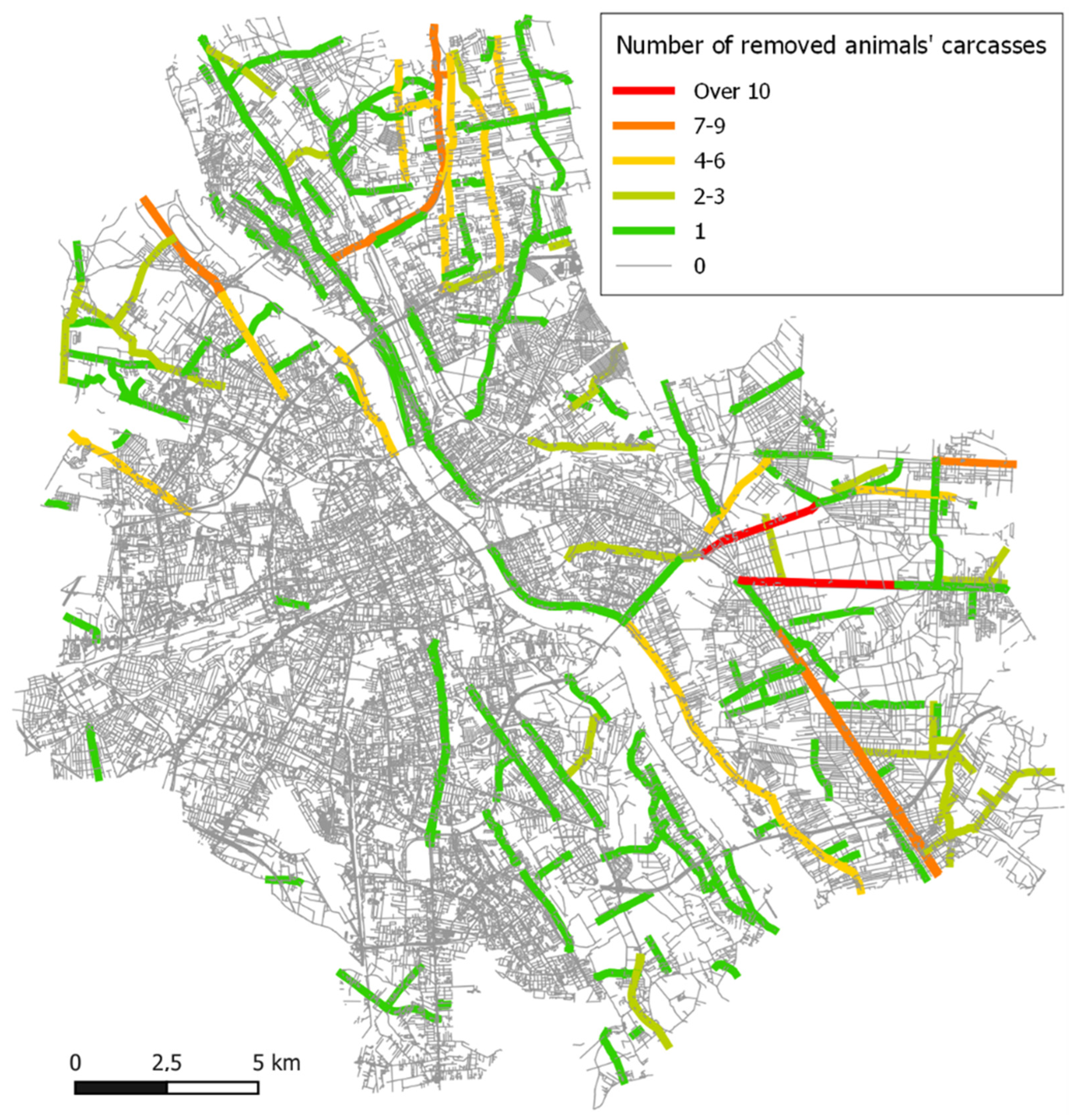
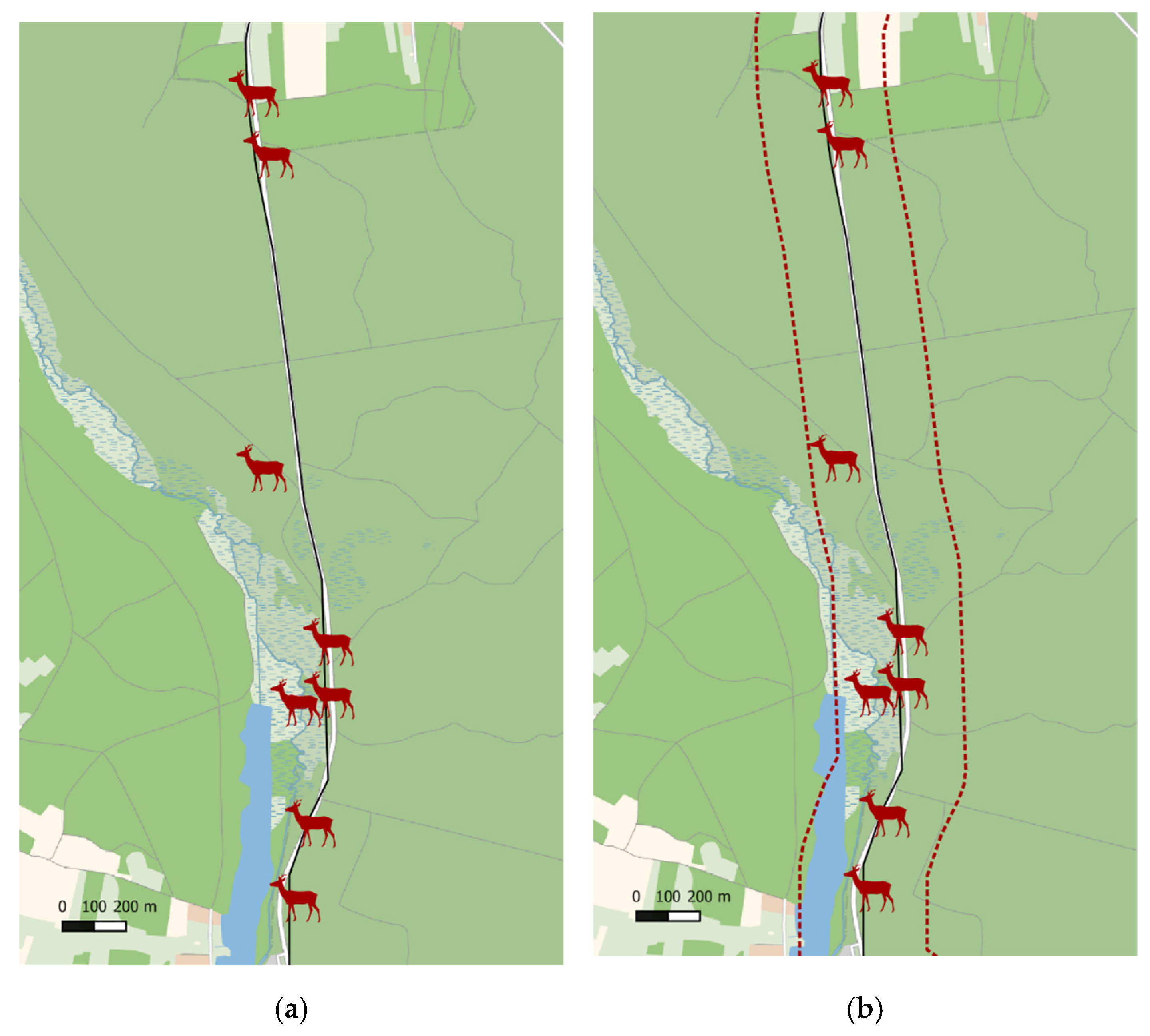
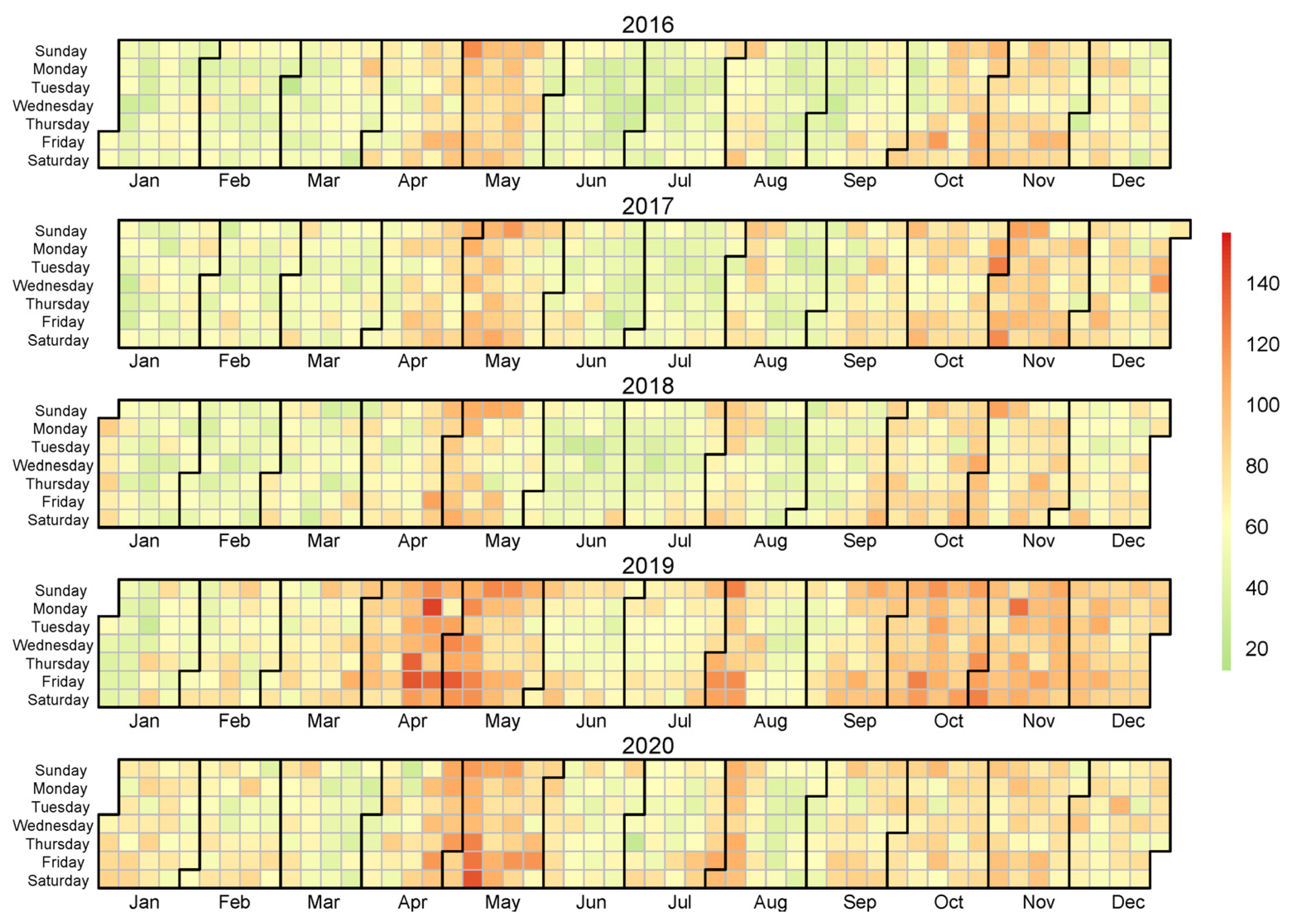
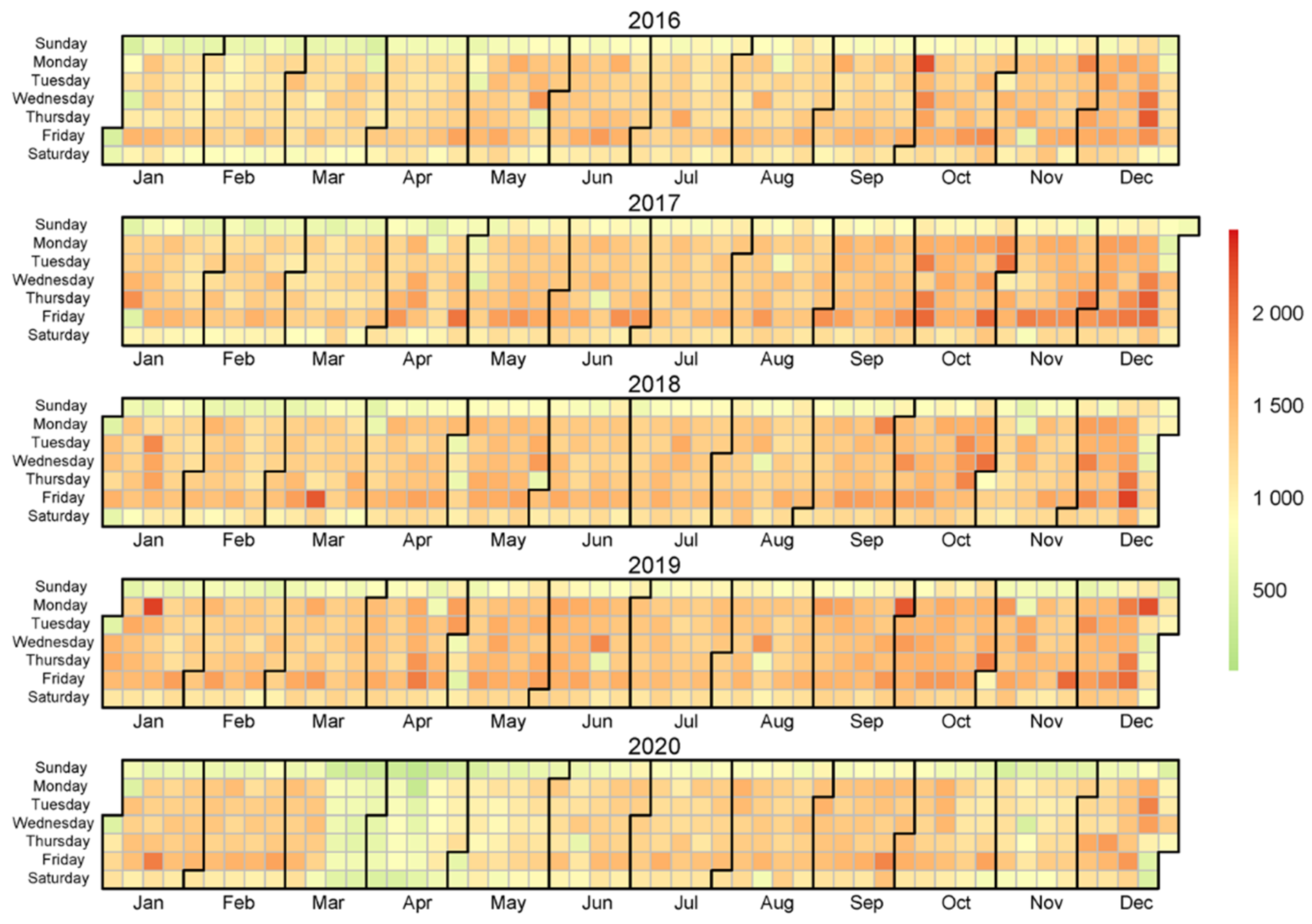
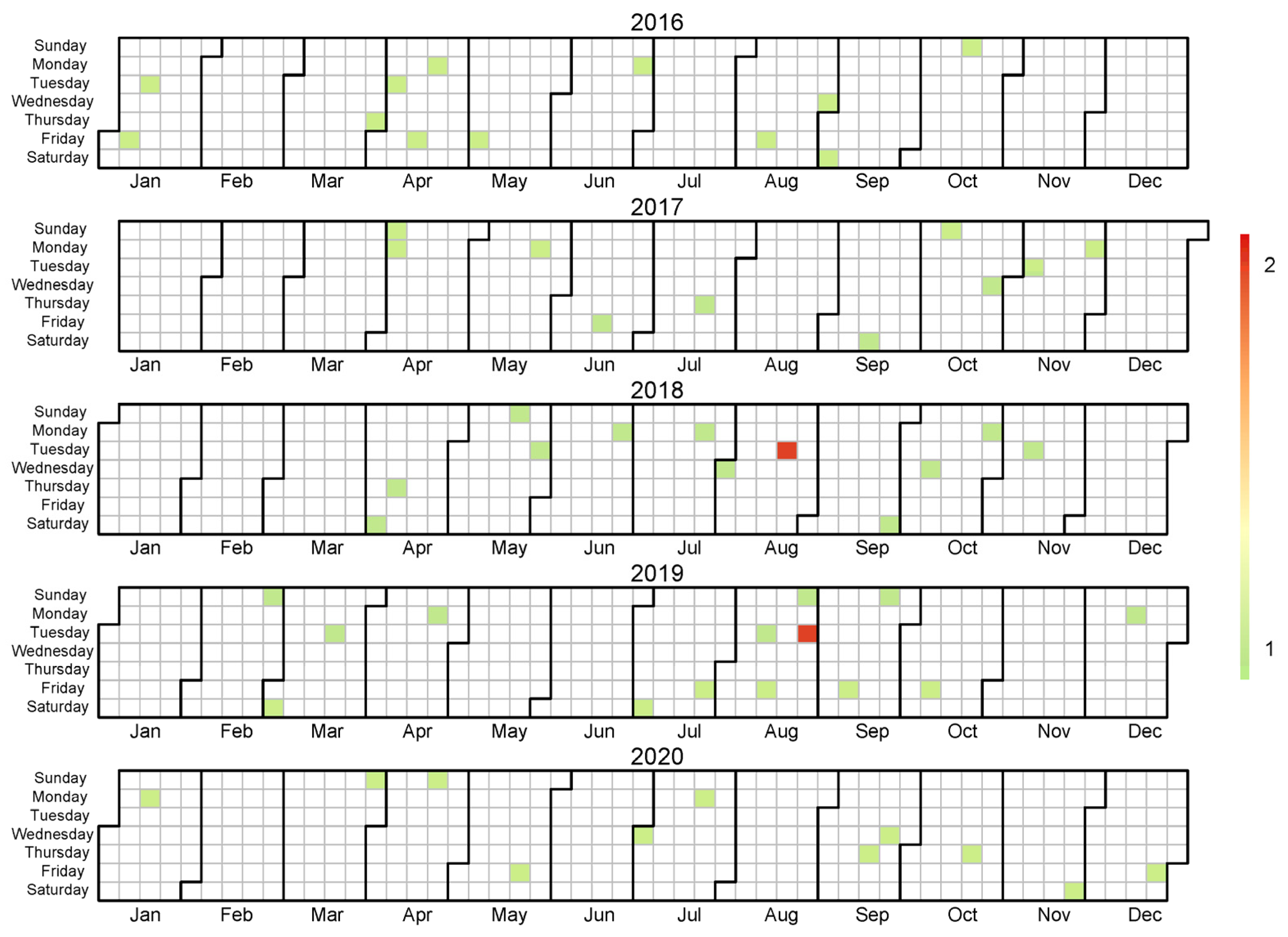

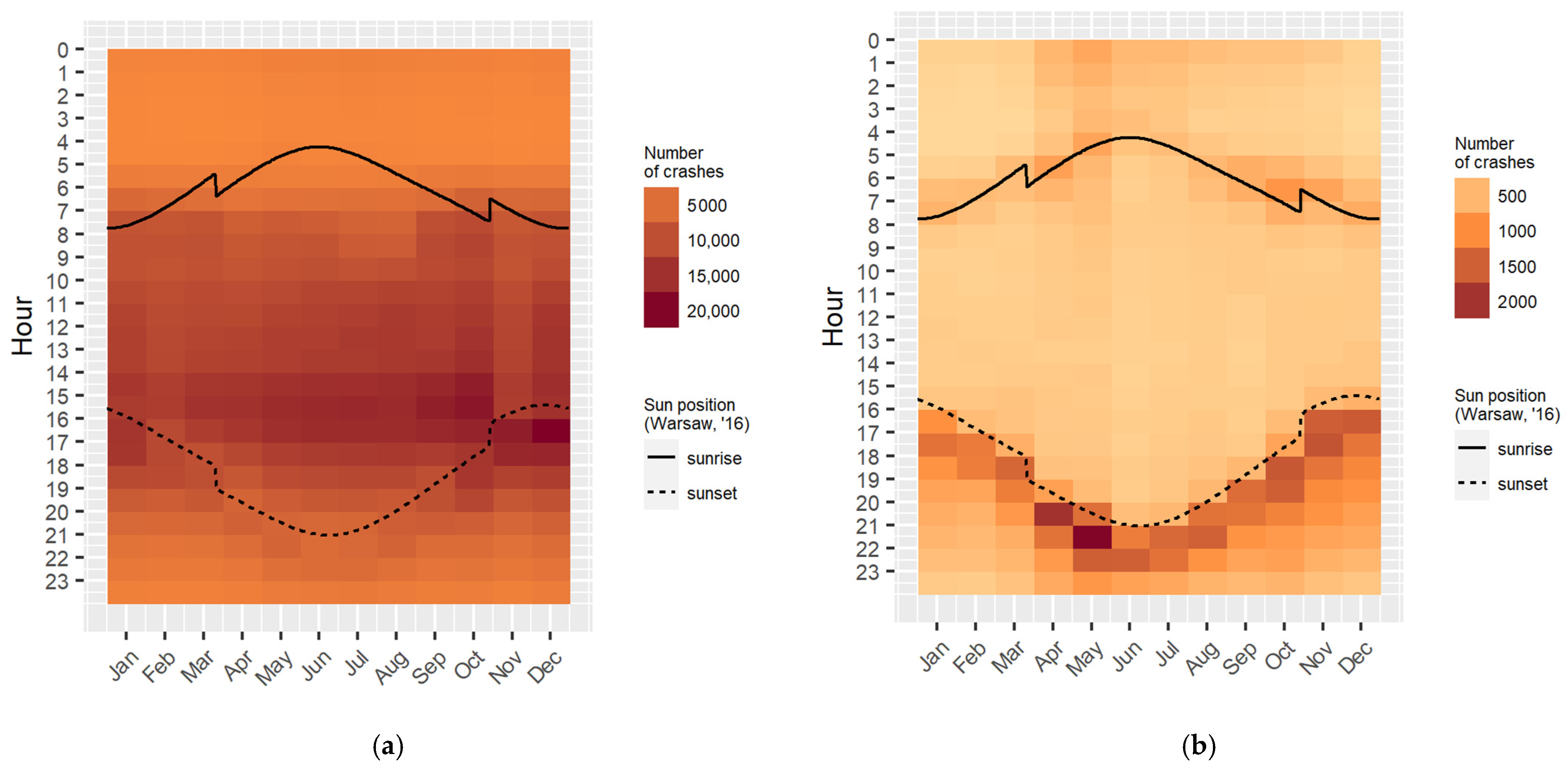



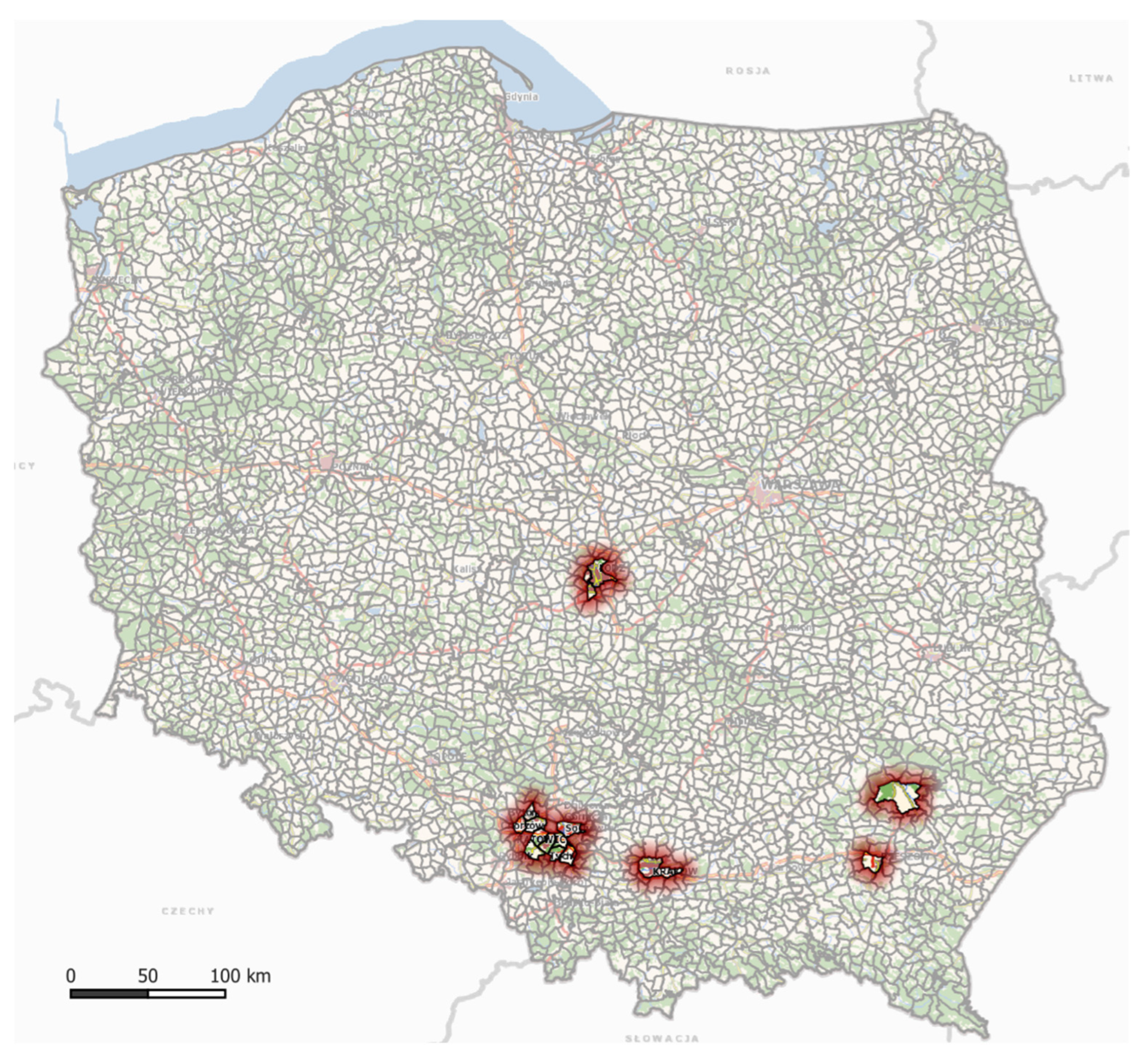

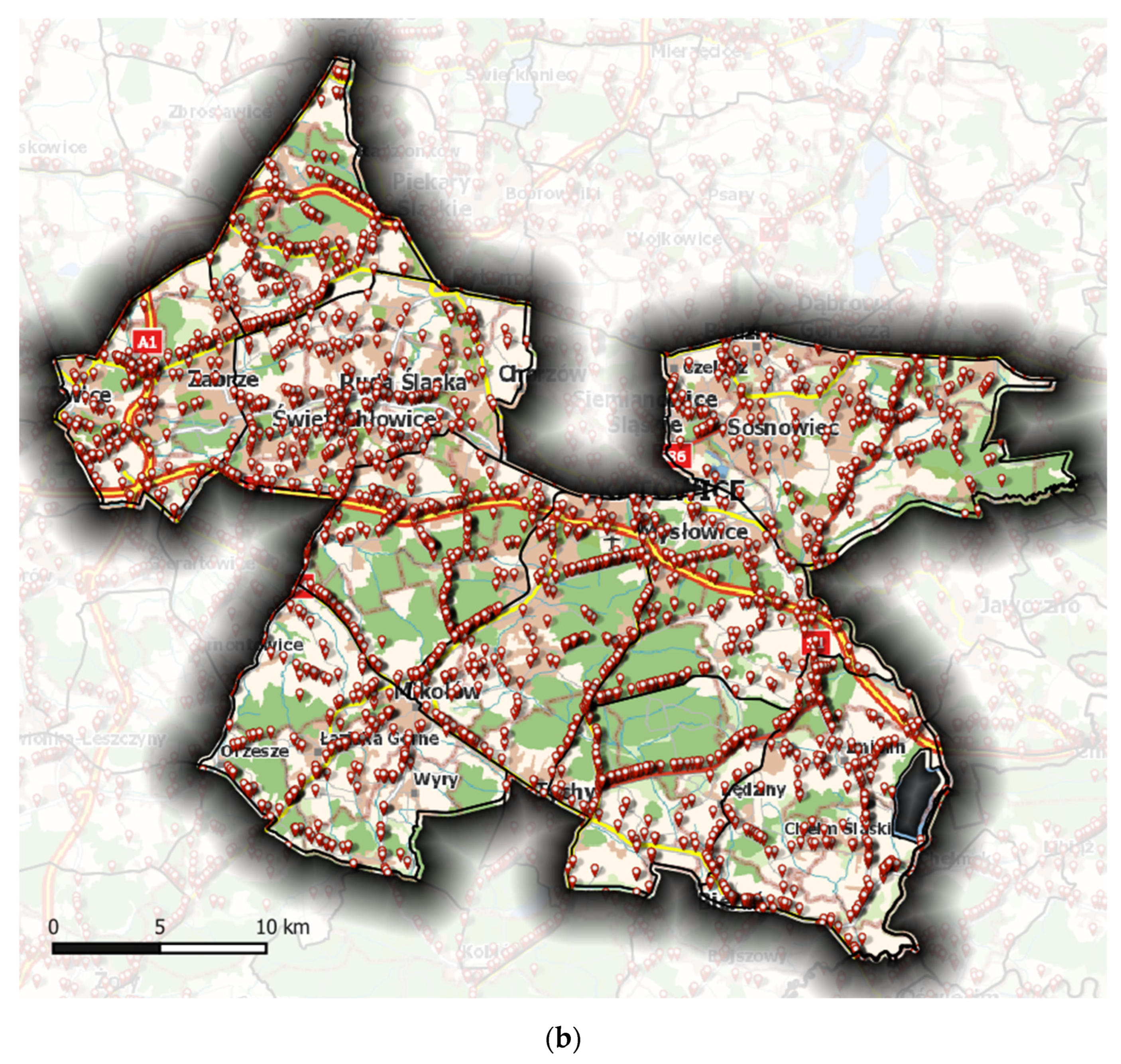
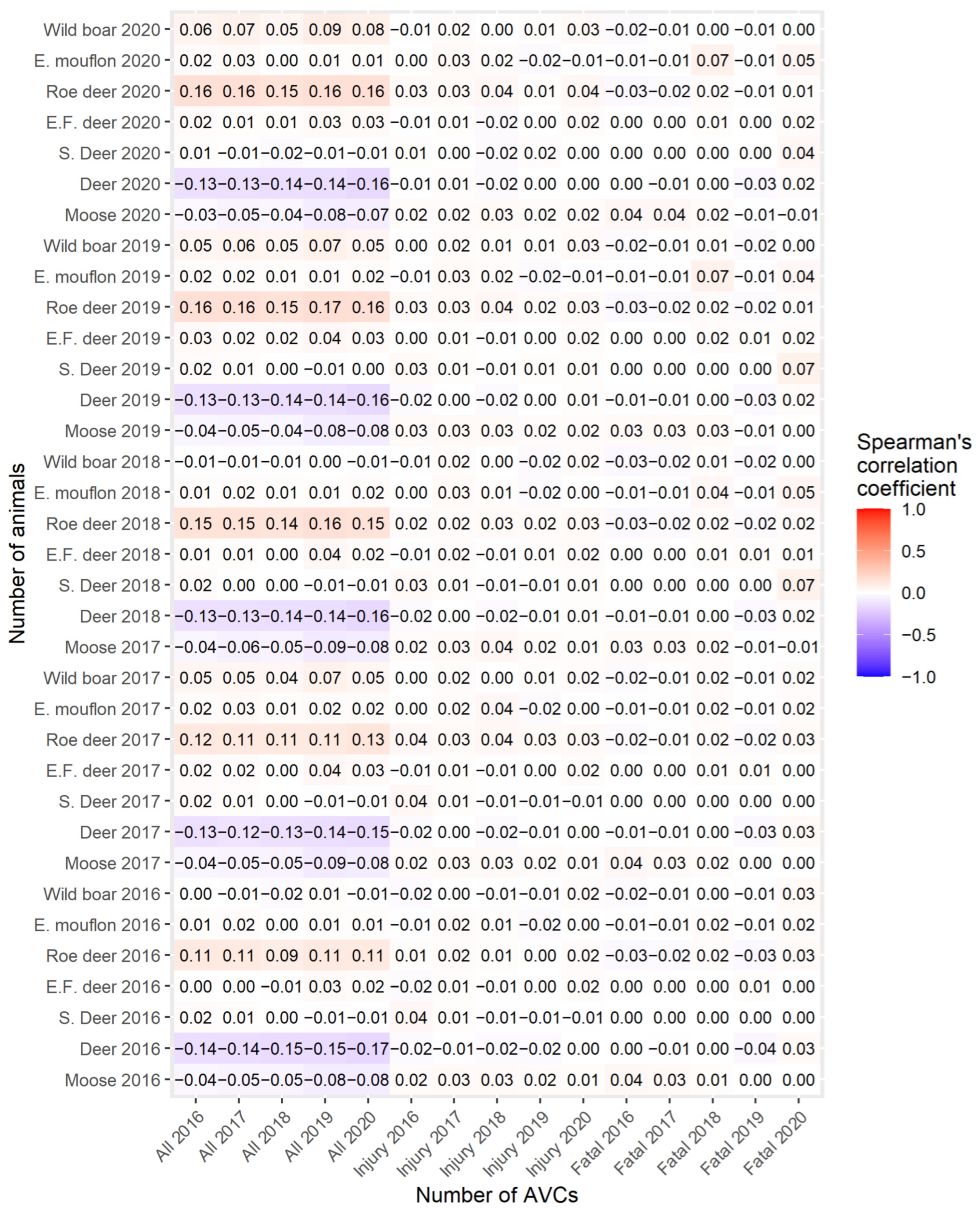


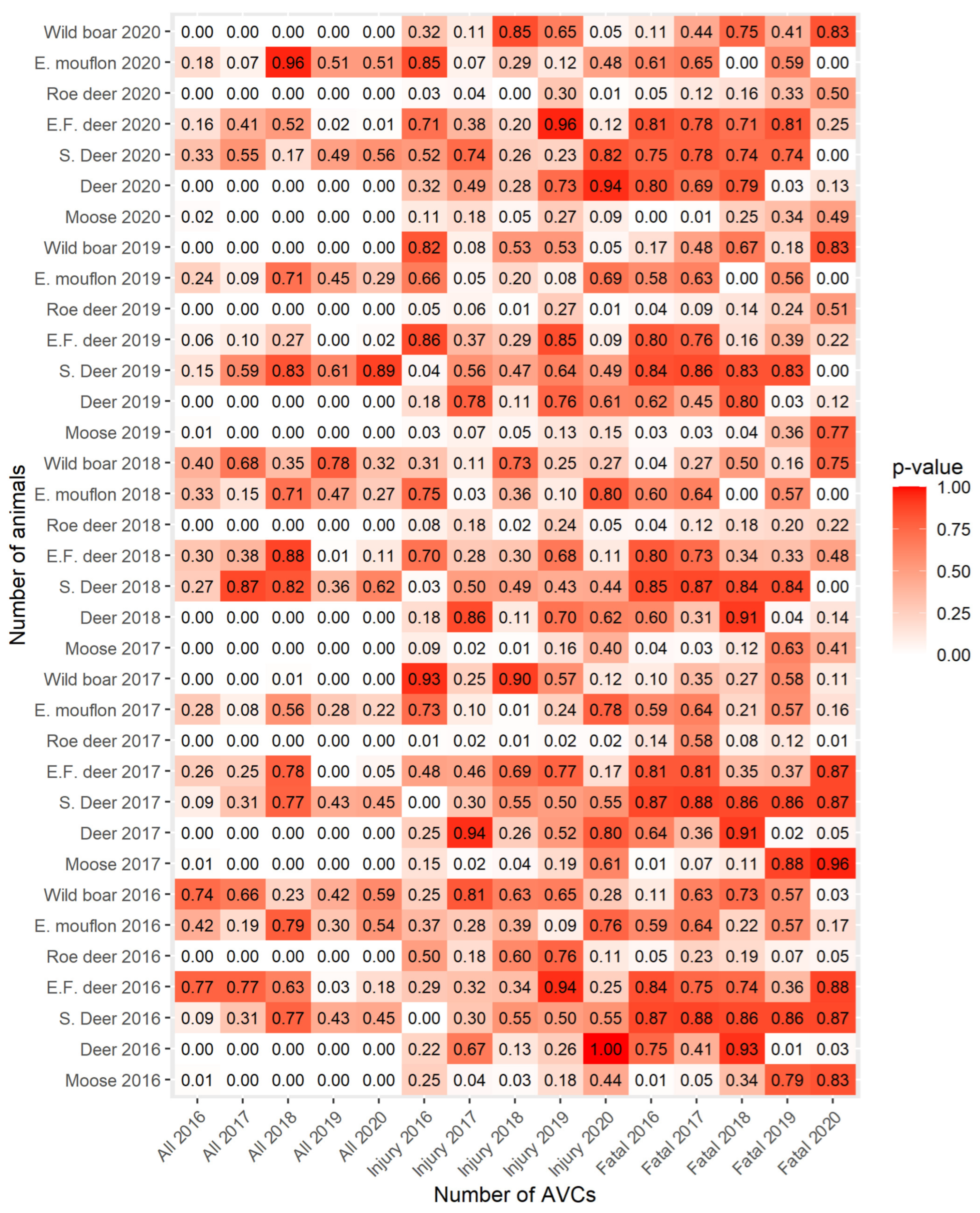
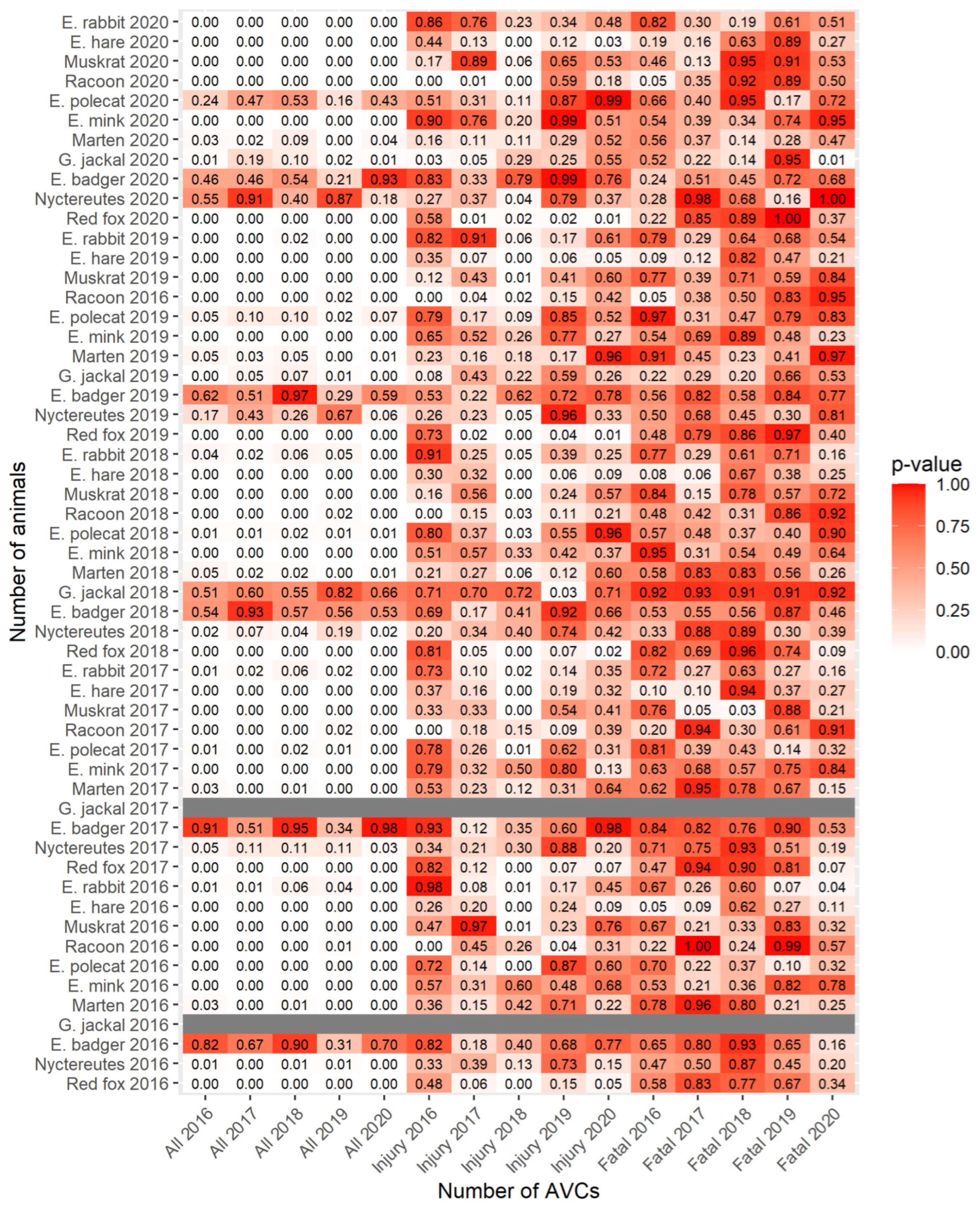

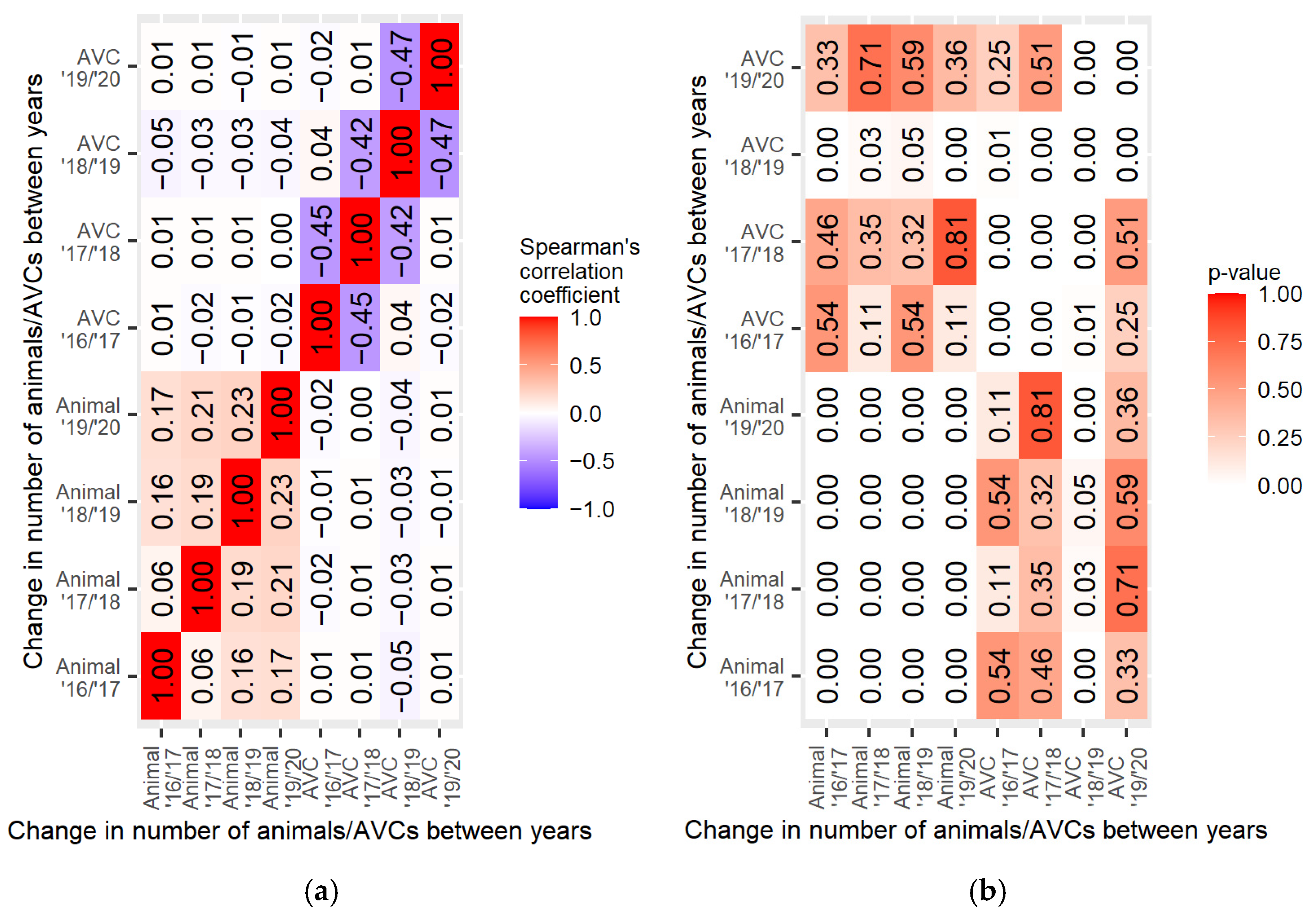
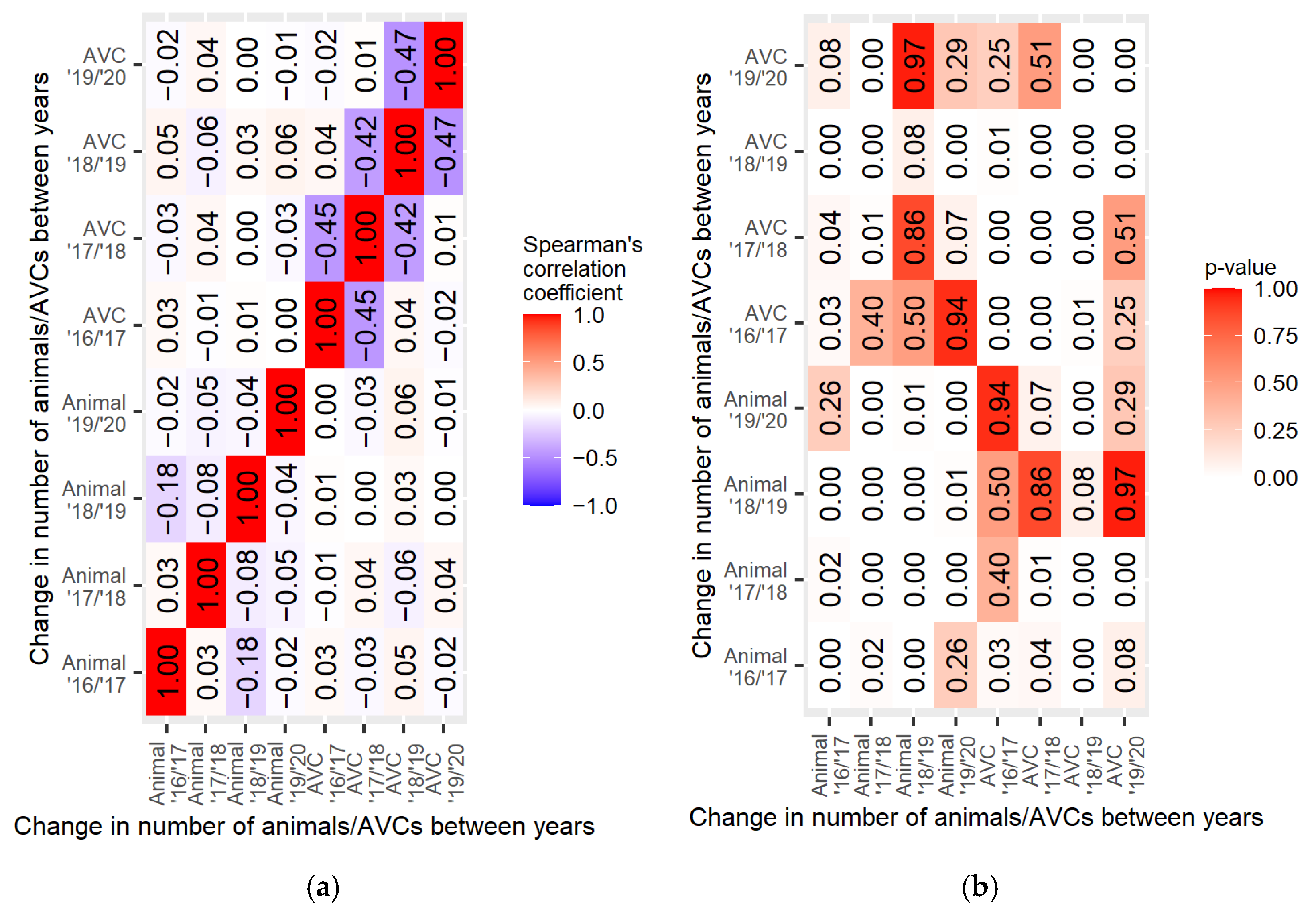

| Road Category | Number of Crashes |
|---|---|
| Motorway | 1484 |
| National road | 34,913 |
| Voivodeship road | 35,221 |
| County road | 38,165 |
| Commune road | 12,919 |
| Other | 165 |
| Not defined | 6005 |
| Voivodeship | Number of Hunting Districts | |
|---|---|---|
| Forest | Field | |
| Mazowieckie | 104 | 495 |
| Opolskie | 44 | 114 |
| Podlaskie | 79 | 242 |
| Zachodniopomorskie | 134 | 156 |
| Voivodeship | Category of Hunting District | ||||
|---|---|---|---|---|---|
| Very Poor | Poor | Moderate | Good | Very Good | |
| Lubelskie | 263 | 63 | 3 | - | - |
| Mazowieckie | 373 | 210 | 15 | 1 | - |
| Zachodniopomorskie | 56 | 65 | 95 | 64 | 5 |
| Category of Hunting District | Category of Hunting District | |||
|---|---|---|---|---|
| Very Poor | Poor | Moderate | Good | |
| Poor | 0.00058 | - | - | - |
| Moderate | 7.6 × 10−8 | 0.01641 | - | - |
| Good | 1.9 × 10−13 | 4 × 10−7 | 0.03745 | - |
| Very good | 0.28708 | 0.67554 | 1 | 1 |
Publisher’s Note: MDPI stays neutral with regard to jurisdictional claims in published maps and institutional affiliations. |
© 2022 by the authors. Licensee MDPI, Basel, Switzerland. This article is an open access article distributed under the terms and conditions of the Creative Commons Attribution (CC BY) license (https://creativecommons.org/licenses/by/4.0/).
Share and Cite
Krukowicz, T.; Firląg, K.; Chrobot, P. Spatiotemporal Analysis of Road Crashes with Animals in Poland. Sustainability 2022, 14, 1253. https://doi.org/10.3390/su14031253
Krukowicz T, Firląg K, Chrobot P. Spatiotemporal Analysis of Road Crashes with Animals in Poland. Sustainability. 2022; 14(3):1253. https://doi.org/10.3390/su14031253
Chicago/Turabian StyleKrukowicz, Tomasz, Krzysztof Firląg, and Paweł Chrobot. 2022. "Spatiotemporal Analysis of Road Crashes with Animals in Poland" Sustainability 14, no. 3: 1253. https://doi.org/10.3390/su14031253
APA StyleKrukowicz, T., Firląg, K., & Chrobot, P. (2022). Spatiotemporal Analysis of Road Crashes with Animals in Poland. Sustainability, 14(3), 1253. https://doi.org/10.3390/su14031253






